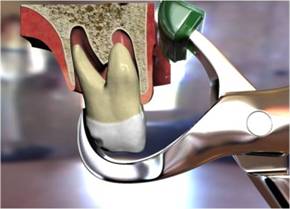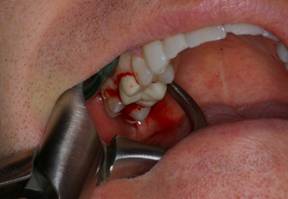Tooth Extraction: Biochemistry Using Dental Extraction Forceps
It is generally thought that during a tooth extraction the physical change of expanding the alveolar bone (socket) along with the severing of the periodontal ligament is the basis of such procedure. Albeit that this does happen, an understanding of what is occurring biochemically is even more important. When the periodontal ligament is traumatized with dental extraction forceps or elevators, hyaluronidase (hyluronate glycanohydrolase) is released.
This is an enzyme that catalyzes the hydrolysis of the interstitial barrier, hyaluronan (hyaluronic acid), which is the cement substance (extracellular matrix) of all human tissue. Once this chemical breakdown of the periodontal ligament by hyaluronidase is sufficient, the tooth is released from its attachment to the alveolus and can be removed.
This explains why the dental extraction forceps by Golden Dental Solutions called the Physics Forceps with its steady unrelenting trauma to the periodontal ligament quantitatively creates a greater release of hyaluronidase in a shorter period of time than traditional oral surgery forceps or elevator tooth extractions because the trauma from those techniques is intermittent. Hence, the use of the Physics Forceps is more efficient, faster, and less traumatic to the alveolar bone than conventional dental extraction forceps or other dental instruments.
The Physics Forceps have a revolutionary beak and bumper™ design that allows for efficient atraumatic extraction using only wrist movement based on a class I lever. The Physics Forceps technique eliminates the need to firmly grasp, twist, rock, push and pull with your arm.
The Physics Forceps act simply like a class I lever, where only one force is applied with the beak on the lingual aspect of the tooth or root (even if bad teeth, rotted, etc.). Once the beak is placed, the bumper is placed on the alveolar ridge at the approximate location of the mucogingival junction to balance the beak. The beak grasps the tooth, while the bumper is the fulcrum to provide leverage and stability for the beak and wrist movement.

Once the dental extraction forcep is properly placed, pressure is slowly applied using only wrist movement. Apply a steady and gentle pressure toward the buccal with only your wrist waiting for the internal force or "creep" to build up allowing the bone to slowly expand and the periodontal ligament to release at which point the tooth will disengage from its socket (knows as the "pop"). The buccal only rotation of the tooth is only successful by rotating your wrist, very similar to a bottle opener, but in reverse.
The Physics Forceps dental extraction forceps technique of effortlessly waiting for this biochemical reaction to take place makes them work better than the traditionally taught tooth extraction methods using conventional dental extraction forceps or any other dental instruments. Reference:
Tooth Extraction: Biochemistry Using Dental Extraction Forceps. Frasher, J.R.E et al; Laurent, T.C.; Laurent, U.B.G. (1997) "Hyaluronan: its nature, distribution, functions and turnover" Journal of Internal Medicine 242: 27-33
Learn more and eliminate tooth extraction frustration forever at www.physicsforceps.com and by calling 1-877-987-2284. Atraumatic extractions have never been easier.
Golden Dental Solutions (formerly known as GoldenMisch).
Back to More Reading
This is an enzyme that catalyzes the hydrolysis of the interstitial barrier, hyaluronan (hyaluronic acid), which is the cement substance (extracellular matrix) of all human tissue. Once this chemical breakdown of the periodontal ligament by hyaluronidase is sufficient, the tooth is released from its attachment to the alveolus and can be removed.
This explains why the dental extraction forceps by Golden Dental Solutions called the Physics Forceps with its steady unrelenting trauma to the periodontal ligament quantitatively creates a greater release of hyaluronidase in a shorter period of time than traditional oral surgery forceps or elevator tooth extractions because the trauma from those techniques is intermittent. Hence, the use of the Physics Forceps is more efficient, faster, and less traumatic to the alveolar bone than conventional dental extraction forceps or other dental instruments.
The Physics Forceps have a revolutionary beak and bumper™ design that allows for efficient atraumatic extraction using only wrist movement based on a class I lever. The Physics Forceps technique eliminates the need to firmly grasp, twist, rock, push and pull with your arm.
The Physics Forceps act simply like a class I lever, where only one force is applied with the beak on the lingual aspect of the tooth or root (even if bad teeth, rotted, etc.). Once the beak is placed, the bumper is placed on the alveolar ridge at the approximate location of the mucogingival junction to balance the beak. The beak grasps the tooth, while the bumper is the fulcrum to provide leverage and stability for the beak and wrist movement.

Physics Forceps - Beak & Bumper™ Placement (animation) of
Dental Extraction Forceps
Dental Extraction Forceps

Physics Forceps - Beak & Bumper™ Placement of Dental Extraction Forceps
Provided by Dr. Ara Nazarian, DDS
Once the dental extraction forcep is properly placed, your hands (or fingers) should be loosely placed toward the end of the handles to obtain maximum leverage. This may be simply two fingers or any similar position where the dental extraction forcep feels comfortable in your hand as long as you are not squeezing the handles.Provided by Dr. Ara Nazarian, DDS
Once the dental extraction forcep is properly placed, pressure is slowly applied using only wrist movement. Apply a steady and gentle pressure toward the buccal with only your wrist waiting for the internal force or "creep" to build up allowing the bone to slowly expand and the periodontal ligament to release at which point the tooth will disengage from its socket (knows as the "pop"). The buccal only rotation of the tooth is only successful by rotating your wrist, very similar to a bottle opener, but in reverse.
The Physics Forceps dental extraction forceps technique of effortlessly waiting for this biochemical reaction to take place makes them work better than the traditionally taught tooth extraction methods using conventional dental extraction forceps or any other dental instruments. Reference:
Tooth Extraction: Biochemistry Using Dental Extraction Forceps. Frasher, J.R.E et al; Laurent, T.C.; Laurent, U.B.G. (1997) "Hyaluronan: its nature, distribution, functions and turnover" Journal of Internal Medicine 242: 27-33
Learn more and eliminate tooth extraction frustration forever at www.physicsforceps.com and by calling 1-877-987-2284. Atraumatic extractions have never been easier.
Golden Dental Solutions (formerly known as GoldenMisch).
Back to More Reading

 Make my Life Easier - Send me Free Informational DVD
Make my Life Easier - Send me Free Informational DVD Keep on Pulling - I Just Need Bumpers
Keep on Pulling - I Just Need Bumpers


